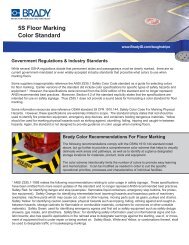POWER UP A WINNER - Plant Services
POWER UP A WINNER - Plant Services
POWER UP A WINNER - Plant Services
You also want an ePaper? Increase the reach of your titles
YUMPU automatically turns print PDFs into web optimized ePapers that Google loves.
from the editor<br />
paul studebaker, cmrp<br />
Who Will Pay<br />
How to win the carbon game<br />
Ongoing climate-change treaty negotiations in preparation<br />
for the November 2009 United Nations Climate Conference<br />
have focused a lot of attention on the costs of carbon<br />
emissions. President Obama has pledged to put the United<br />
States on a path to cut emissions to 1990 levels by 2020 (with<br />
an additional 80% reduction by 2050).<br />
The current Kyoto Protocol covers only about 30% of<br />
global emissions, mainly because the United States and<br />
China didn’t ratify it, and the rest of the world is unlikely to<br />
go forward without us. So, the world’s leading greenhouse<br />
gas emitters are grappling to determine which country will<br />
lose more ground as a consequence of cleaning up our acts.<br />
U.S. Energy Secretary David Chu recently suggested that the<br />
United States might use tariffs against trading partners who<br />
don’t reduce greenhouse gas emissions. “If other countries don’t<br />
impose a cost on carbon, then we would be at a disadvantage,”<br />
Chu told the House Science and Technology Committee. Import<br />
duties could be used to offset that competitive advantage.<br />
The next day, China climate change negotiator Xie Zhenhua<br />
responded, “I oppose using climate change as an excuse to<br />
practice protectionism on trade.” A dust-up ensued over who<br />
should shoulder the cost of cutting emissions for goods produced<br />
overseas. If a product manufactured in China is sold in<br />
the United States, who’s responsible for its carbon footprint<br />
Li Gao, director of China’s Department of Climate Change,<br />
says countries that buy Chinese goods should be held responsible<br />
for the carbon dioxide emitted during manufacturing.<br />
“About 15% to 25% of China’s emissions come from the<br />
products which we make for the world, which should not be<br />
taken by us,” Gao said at a forum sponsored by the Pew Center<br />
on Global Climate Change. “This share of emission should be<br />
taken by the consumers, not the producers.”<br />
Principles are important, but what’s a ton of CO 2<br />
actually<br />
worth on the global market Numbers commonly bandied<br />
about range from about $10 per ton to $40 per ton, equivalent<br />
to about 10 cents to 40 cents for the 20-odd pounds<br />
generated by combusting a gallon of a fuel like gasoline. This<br />
cost isn’t trivial, but it’s not large compared to the variations<br />
in the cost of the fuel itself during the past year (from about<br />
$2 per gallon to $4 per gallon) brought on by vagaries of<br />
supply, demand and speculation.<br />
People tend to focus on the cost of carbon credits, how<br />
they’ll affect prices of fuel and electricity, who will have to<br />
pay, and whether the government will get the money. But for<br />
a broad range of carbon-emission-reducing activities, the<br />
price is negative – more than offset by lower energy costs. In<br />
effect, a market in greenhouse gas emissions credits offers<br />
smart people a lot of opportunity to improve their competitive<br />
positions and bottom lines.<br />
McKinsey and Co. analyzed more than 250 sources of<br />
U.S. carbon dioxide emissions and the per-ton costs to<br />
For a broad range of carbonemission-reducing<br />
activities,<br />
the price is negative – more than<br />
offset by lOWer energy costs.<br />
reduce them. (See the full report at www.mckinsey.com/<br />
clientservice/ccsi/pdf/Greenhouse_Gas_Emissions_Execu<br />
tive_Summary.pdf.) They found that the United States could<br />
reduce greenhouse gas emissions by about 3 gigatons CO 2<br />
equivalent by 2030, using tested approaches and high-potential<br />
emerging technologies, at marginal costs of less than<br />
$50 per ton. The total outlay between now and 2030 would<br />
average $50 billion a year, a total of about $1 trillion.<br />
That’s chump change at AIG, but more interesting are<br />
McKinsey’s calculations of measures that offer sizeable paybacks<br />
for CO 2<br />
-equivalent reductions. These include:<br />
• Higher-efficiency commercial and residential electronics:<br />
$90 per ton<br />
• Residential and commercial lighting: $80 to $90 per ton<br />
• Combined heat and power: $15 to $40 per ton<br />
• Industrial process improvements: $15 per ton<br />
Bear in mind, these measures pay back whether or not a<br />
value is attached to those tons of greenhouse gases. Any significant<br />
U.S. market for carbon credits will add the prevailing<br />
per-ton price to those returns.<br />
While Chu, Zhenhua and Gao brandish words about who<br />
should get stuck with the bill for greenhouse gas emissions,<br />
the smart money is lining up behind the people who understand<br />
how avoid them in the first place.<br />
Paul STUDEBAKer, CMRP, Editor In Chief<br />
pstudebaker@putman.net, (630) 467-1300 ext. 433<br />
www.PLANTSERVICES.com APRIL 2009 7












